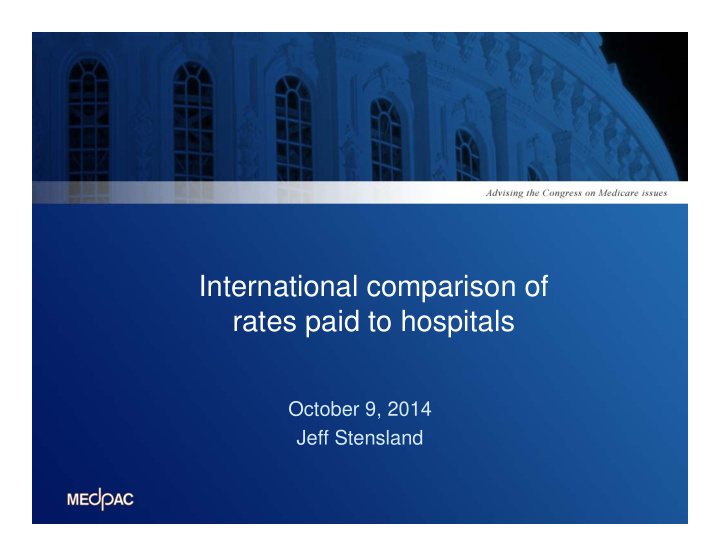



International comparison of rates paid to hospitals October 9, 2014 Jeff Stensland
International comparisons in the literature U.S. spends over 17% of GDP on healthcare, 50% more than the next highest country U.S. spends more on hospitals and nursing homes 6.4% of GDP (OECD 2009 data) 4.8% in comparable countries Due to higher rates, not higher volume Fewer admissions per capita in U.S. Shorter length of stay in U.S. 2
The questions for today How do rates paid by Medicare compare to international rates? How do hospital costs compare? To what extent do higher input prices drive costs to be higher in the U.S. ? To what extent do greater quantities of inputs (e.g., labor, supplies) drive higher costs in the U.S.? 3
How much higher are U.S. rates? Medicare rates are roughly 50% higher than OECD rates for an inpatient stay (hospital and physician combined) Costs of a hospital stay are also close to 50% higher in the U.S. Commercial rates are often over 100% higher than in comparable countries, but vary widely from hospital to hospital Data are preliminary and subject to change 4
Why are costs roughly 50% higher? Most input prices are roughly 50% higher in the U.S. Medicare pays physician roughly 50% more than physician labor costs in comparable countries (OECD/Urban Institute data) Nurses make about 50% more in the U.S. (OECD data) The literature suggests that drugs and devices also cost about 50% more Some other smaller categories of cost are not more expensive (e.g., utilities) Data are preliminary and subject to change 5
International rate differences after adjusting rates for input prices International Medicare Commercial insurer 25 th to 75 th percentile Hip replacement rate range* Average Rate including $9,000 to physician fees $12,000 $17,000 $25,000 to $88,000 Rate as a share of the average person’s wage 20 to 26% 31% 46% to 161% Rate as a share of the average RN wage (a 20 to 26% 24% 36% to 126% proxy for input prices) Note: * Range is for the 2 nd and 5 th highest rates out of six countries: Australia, France, Netherlands, New Zealand, Switzerland, and the United Kingdom. Rates include the amount paid for physician fees. Source: CMS data on average Medicare hospital payments for joint replacement and data on physician payments. Data on rates in other countries are from the International Federation of Health Plans. All rates are adjusted for purchasing power parity using data from the Organization for Economic Cooperation and Development (OECD). Wage data is from the OECD. Data are preliminary and subject to change 6
Why are input prices higher? Individuals with higher education tend to make relatively higher salaries in the U.S., but the wage premium is even higher for health care workers Financial pressure on hospitals can affect wages of employees Insurers have less leverage over hospitals in the U.S. Higher hospital revenues can lead to higher wages in the U.S. Drug and device prices are higher in the U.S. 7
If we wanted to restrain input prices, does Medicare have the tools? Medicare program can control Medicare rates. Lower Medicare updates may slightly reduce input price growth. The gap between Medicare hospital rates and private insurer hospital rates will grow If private insurers do not restrained the rates they pay hospitals, it may be difficult to constrain Medicare rates in the long run Medicare has not traditionally directly influenced drug or device input prices 8
Administrative costs also higher in the U.S. Costs of administrative and billing labor 10% of hospital costs in the U.S. 5 to 6% in Germany and France Hospital CEO salaries have received significant attention in the press and literature The key driver is the greater administrative complexity of U.S. system that results in a large number of administrative support employees Data are preliminary and subject to change 9
Reducing administrative costs Align public and private billing systems Simplify quality reporting, move to fewer measures that emphasize outcomes Site neutral payments: Removes incentives to move lower priced services to hospitals where overhead is higher Improve the Recovery Audit Contractor (RAC) auditing and appeals process 10
Summary Medicare rates are roughly 50% above international rates The difference is similar to the difference in costs The difference in costs can largely be explained by input prices U.S. commercial rates are 100% higher and cannot be explained by input prices The Medicare program has limited tools to lower input prices Reducing administrative costs is more feasible, but has a smaller effect on overall costs 11
Discussion What can the Medicare program do to reduce administrative costs? How should Medicare set rates in an environment with high and increasing commercial rates? 12
Recommend
More recommend